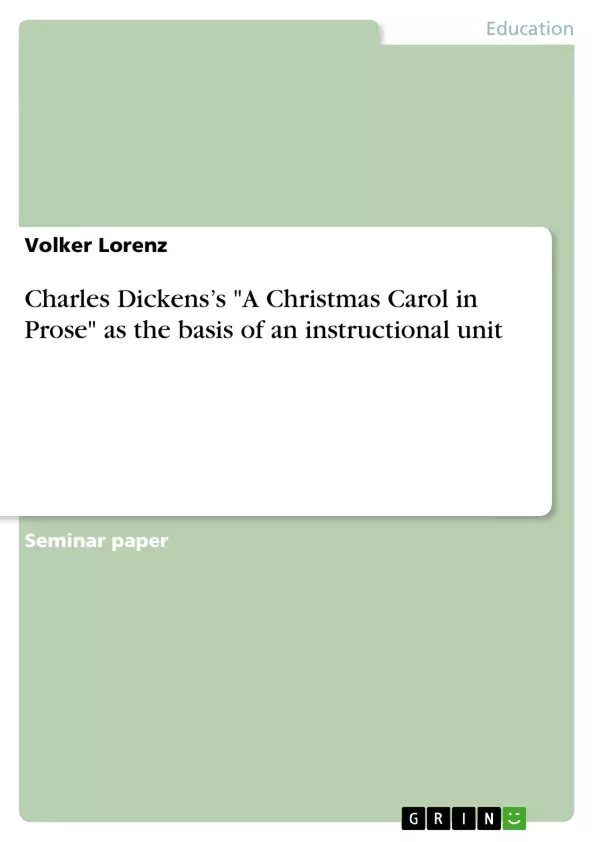While the traditional use of literature at schools usually relies on interpretation and the existence of a ‘correct’ way of interpreting the text, more recent theories like the aesthetics of reception focus on the dynamic interaction between the text and its readers, aiming at a type of aesthetic reading.
Charles Dickens’s novel of the miser Ebenezer Scrooge being visited by the three ghosts of Christmas and turning over to a new leaf is probably one of the best-known English novels; it is alluded to in many other pieces of literature, in films and even comics. This, banal as it may be, is already the first reason for choosing A Christmas Carol as a topic, since all the gags and allusions elsewhere would not be understood without some knowledge of Dickens’s novel.
Reading experiences also play an important role when it comes to motivation: other classic novels by Dickens like Oliver Twist, Great Expectations or David Copperfield, or their film adaptations may serve as a motivation for reading A Christmas Carol, or vice versa.
Finally, apart from conveying a moral message, Dickens’s story also portraits the Victorian age of Britain and its nuisances as vivid as only few other novels, which stays in mind far better than only hearing a report.
Inhaltsverzeichnis (Table of Contents)
- Literary didactics
- A Christmas Carol - Why such a 'hackneyed' story?
- Possibilities of using Dickens in the classroom
- Elements of the instructional unit
- Preparation
- Introduction to the novel
- The first of the three ghosts
- The second of the three ghosts
- The last of the ghosts and the end of the Carol
- Adaptations of the text
- Leading over to Christmas in general
- A model syllabus
- References
Zielsetzung und Themenschwerpunkte (Objectives and Key Themes)
The aim of this paper is to present a comprehensive instructional unit based on Charles Dickens’s “A Christmas Carol” for the German English classroom. The unit explores the novel’s literary and cultural significance, analyzing its themes, characters, and language, while engaging students in a variety of creative and interactive activities.
- The role of literature in foreign language teaching
- Exploring the cultural and historical context of Dickens’s “A Christmas Carol”
- Analyzing the themes of redemption, social justice, and the importance of compassion
- Engaging with the novel’s characters and their development
- Using the novel as a springboard for interdisciplinary learning and creative expression
Zusammenfassung der Kapitel (Chapter Summaries)
The first chapter provides an overview of literary didactics and its application to foreign language teaching, emphasizing the potential of literature to foster empathy, cultural understanding, and language acquisition. The second chapter examines the enduring popularity of "A Christmas Carol" and its significance as a classic text, highlighting its potential for engaging students and exploring its relevance in contemporary society.
The third chapter focuses on the diverse possibilities for using Dickens's work in the classroom, exploring various aspects of the novel that can be used for analyzing characters, examining the setting, exploring Victorian times, and engaging with the language of the text. The fourth chapter outlines the elements of the instructional unit, including the preparation phase, introduction to the novel, analysis of the three ghosts, and exploration of adaptations and connections to Christmas traditions.
Schlüsselwörter (Keywords)
The primary keywords and focus topics of this paper include literary didactics, “A Christmas Carol,” Charles Dickens, Victorian literature, cultural context, thematic analysis, character development, interdisciplinary learning, and creative expression. The paper explores these concepts within the framework of foreign language teaching, utilizing Dickens’s novel as a vehicle for promoting language acquisition, cultural understanding, and critical thinking.
- Quote paper
- Volker Lorenz (Author), 2005, Charles Dickens’s "A Christmas Carol in Prose" as the basis of an instructional unit, Munich, GRIN Verlag, https://www.grin.com/document/93545



